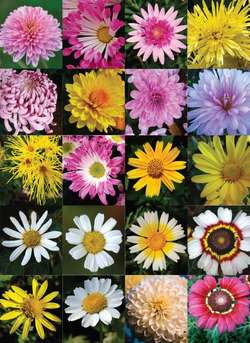chrysanthemum
(redirected from Chrysanthemum moriflorum)Also found in: Dictionary, Thesaurus, Medical.
chrysanthemum
chrysanthemum
Chrysanthemum
a genus of annual and perennial herbaceous shrubs of the family Compositae. There are about 150 species, growing mainly in Europe, Asia, and Africa; 70 to 80 species occur in the USSR. The plants are 0.5–1.5 m tall. The dark-green leaves are entire or dissected, and the flowers are almost all ligulate and gathered into heads. Many species have long been cultivated as ornamentals. In China, India, Korea, and other Asian countries the stems, leaves, and inflorescences are eaten as vegetables. The plants are widely used in Chinese medicine.
The best-known annual species are the tricolor chrysanthemum (C. carinatum), whose white inflorescences are tinted with yellow and red-brown circles, and the garland chrysanthemum (C. coronarium), which has white double inflorescences. Both species are unfastidious, rapidly flowering garden plants; they are propagated by seeds which are sown before winter or in the spring. The corn marigold (C. segetum), an annual with yellow and white inflorescences, is grown principally for cutflowers (the flowers last well in water) and as winter pasturage; varieties include Polar Star, Star of the East, and Helios. Perennials include the Shasta daisy (C. maximum) and pyrethrum (C. coceineum), both of which are cultivated in open ground. The perennial golden-leaved feverfew (C. parthenium var. aureum) is cultivated as a border plant. There are numerous varieties and forms of C. indicum and C. coreanum.
Chrysanthemums are important in commercial floriculture in Western Europe, Japan, the USA, the USSR, and other countries. In the central and northern regions of the USSR they are grown in pots in greenhouses; in the Caucasus, Crimea, and Middle Asia they are grown in open ground. Green cuttings are rooted in hothouses in January to May. The seedlings are transplanted to pots, and then in June the plants are set out in beds. In autumn the plants are placed in cold greenhouses at temperatures of 10°–12°C. In November and December the chrysanthemums are sold. Large-flowered varieties include Indianapolis (white flowers), Fred Joule (bronze-orange flowers), Luyona (yellow flowers), and Woking Scarlet (orange-red flowers). Small-flowered varieties include Alaska (white flowers), Flem Gaunti (red flowers), and Portrait (purple flowers).
Pests of chrysanthemums include the caterpillars of moths, wireworms, and true bugs; diseases include infection caused by the leaf nematode Aphelenchoides ritzemabosi.
REFERENCES
Krasnova, N. S. Melkotsvetnye khrizantemy v ozelenenii gorodov. Moscow, 1952.Kiselev, G. E. Tsvetovodstvo, 3rd ed. Moscow, 1964.
Spravochnik tsvetovoda. Moscow, 1971.
